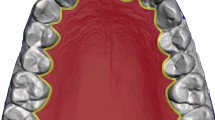Abstract
Studies have shown anatomical and functional differences between men and women with respect to the mouth, pharynx, upper esophageal sphincter, and esophagus. The aim of this investigation was to analyze the influence of gender, body mass index (BMI), age, and orofacial anthropometric measurements on the intraoral maximum volume capacity for liquid. The investigation included asymptomatic subjects, 56 females and 44 males, aged 19–53 years. The volunteers sucked water through a straw up to the maximum tolerated oral volume, which was greater in men (71.2 ± 15.0 ml) than in women (55.4 ± 13.4 ml). Age, BMI, height, and number of teeth had no influence on the intraoral tolerated volume. Anthropometric orofacial measurements were greater in men than in women. In individuals with height between 1.66 and 1.89 m, anthropometric orofacial measurements were greater in men than in women, and the tolerated intraoral volume was greater in men than in women. There was a positive correlation between orofacial measurements and intraoral maximum volume. In conclusion, men have the capacity to place a larger volume of water inside their mouth than women. This observation is associated with higher anthropometric orofacial measures, but not with age, number of teeth, height, or BMI.


Similar content being viewed by others
References
Felício CM. Sistema estomatognático e funções. In: Felício CM, editor. Fonoaudiologia aplicada a casos odontológicos: motricidade oral e audiologia. São Paulo: Pancast; 1999. p. 36.
Dantas RO, Kern MK, Massey BT, Dodds WJ, Kahrilas PJ, Brasseur JG, Cook IJ, Lang IM. Effect of swallowed bolus variables on oral and pharyngeal phases of swallowing. Am J Physiol. 1990;258:G675–81.
Schultz PerlmanAL, JG Van, Daele DJ. Effects of age, gender, bolus volume, and bolus viscosity on oropharygeal pressure during swallowing. J Appl Physiol. 1993;75:33–7.
Adeleye B, Rachal C. Comparison of the rheological properties of ready-to-serve and powdered instant food-thickened beverages at different temperatures for dysphagic patients. J Am Diet Assoc. 2007;107:1176–82.
Bass NH. The neurology of swallowing. In: Groher ME, editor. Dysphagia–diagnosis and management. Boston: Butterworth-Heinemann; 1997. p. 7–35.
Lawless HT, Bender S, Oman C, Pelletier C. Gender, age, vessel size, cup vs. straw sipping, and sequence effects on sip volume. Dysphagia. 2003;18:196–202.
Hughes TA, Wiles CM. Clinical measurement of swallowing in health and in neurogenic dysphagia. QJM. 1996;89:109–16.
Alves LM, Cassiani RA, Santos CM, Dantas RO. Gender effect on the clinical measurement of swallowing. Arq Gastroenterol. 2007;44:227–9.
Dantas RO, Ferriolli E, Souza MAN. Gender effects on esophageal motility. Braz J Med Biol Res. 1998;31:539–44.
Gluckman A. Sexual dimorphism in human and mammalian biology and pathology. New York: Academic Press; 1981.
Dantas RO, Cassiani RA, Santos CM, Gonzaga GM, Alves LM, Mazin SC. Effect of gender on swallow event duration assessed by videofluoroscopy. Dysphagia. 2008;24:280–4.
Adnerhill I, Ekberg O, Groher ME. Determining normal bolus size for thin liquids. Dysphagia. 1989;4:1–3.
Nilsson H, Ekberg O, Olsson R, Kjellin O, Hindfelt B. Quantitative assessment of swallowing in healthy adults. Dysphagia. 1996;11:110–6.
Psillakis JM, Lucardi V. Proporções estéticas da face. In: Psillakis JM, Zanini AS, Mélega JM, Costa EA, Cruz RL, editors. Cirurgia craniomaxilofacial: osteotomias da face. Rio de Janeiro: Medsi; 1987. p. 297–313.
Langlade M. Análise da estética. In: Langlade M, editor. Diagnóstico ortodôntico. São Paulo: Santos; 1995. p. 129–60.
Sunguino R, Ramos AL, Terada HH, Furquim LZ, Maeda L, Silva Filho OG. Análise facial. R Dental Press Ortodon Ortop Maxilar. 1996;1:86–107.
Cattoni DM. O uso do paquímetro na motricidade orofacial: procedimentos de avaliação. Barueri: Pró-Fono; 2006.
World Health Organization. Obesity: preventing and managing the global epidemic. Report of a WHO consultation on obesity. Geneva: World Health Organization, 3–5 June 1997.
Schall R. Estimation in generalized linear models with random effects. Biometrika. 1991;78:719–27.
SAS/STAT® User’s Guide, version 9.0, Cary, NC: SAS Institute Inc., 2002-2003.
Bennett JW, Van Lieshout PHHM, Pelletier CA, Steele CM. Sip-sizing behaviors in natural drinking conditions compared to instructed experimental conditions. Dysphagia. 2009;24:152–8.
Alves LM, Santos CM, Cassiani RA, Dantas RO. Dinâmica da deglutição de líquido em pessoas obesas. GED. 2007;26:187–90.
Nilsson H, Ekberg O, Olsson R, Kjellin O, Hindfelt B. Quantitative aspects of swallowing in an elderly nondysphagic populations. Dysphagia. 1996;11:180–4.
Herdy JL, Nouer PR, Junqueira JL, Gumieiro EH. Morfologia e alterações do perfil facial durante o crescimento. Ortodontia. 2002;35:109–19.
Valente ROH, Oliveira MG. Valores normativos e dimorfismo sexual em perfis esteticamente agradáveis, através das análises cefalométricas computadorizadas (Ricketts e McNamara). Pesq Odontol Bras. 2003;17:29–34.
Enlow DH, Hans MG. Forma e Padrão da Face. In: Enlow DH, Hans MG, editors. Noções básicas sobre crescimento facial. São Paulo: Santos; 2003. p. 130–41.
Mendell DA, Logemann JA. Temporal sequence of swallow events during the oropharyngeal swallow. J Speech Lang Hear Res. 2007;50:1256–71.
Hoffman MR, Ciucci MR, Mielens JD, Jiang JJ, McCulloch TM. Pharyngeal swallow adaptations to bolus volume measured with high-resolution manometry. Laryngoscope. 2010;120:2367–73.
Butler SG, Stuart A, Case LD, Rees C, Vitolins M, Kritchevsky SB. Effect of liquid type, delivery method, and bolus volume on penetration-aspiration scores in healthy older adults during flexible endoscopic evaluation of swallowing. Ann Otol Rhinol Laryngol. 2011;120:288–95.
Ochiai KT, Hojo S, Nakamura C, Ikeda H, Garrett NR. Impact of facial form on the relationship between conventional or implant-assisted mandibular dentures and masticatory function. J Prosthet Dent. 2011;105:256–65.
Author information
Authors and Affiliations
Corresponding author
Rights and permissions
About this article
Cite this article
Nascimento, W.V., Cassiani, R.A. & Dantas, R.O. Gender Effect on Oral Volume Capacity. Dysphagia 27, 384–389 (2012). https://doi.org/10.1007/s00455-011-9379-4
Received:
Accepted:
Published:
Issue Date:
DOI: https://doi.org/10.1007/s00455-011-9379-4




